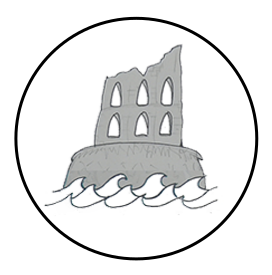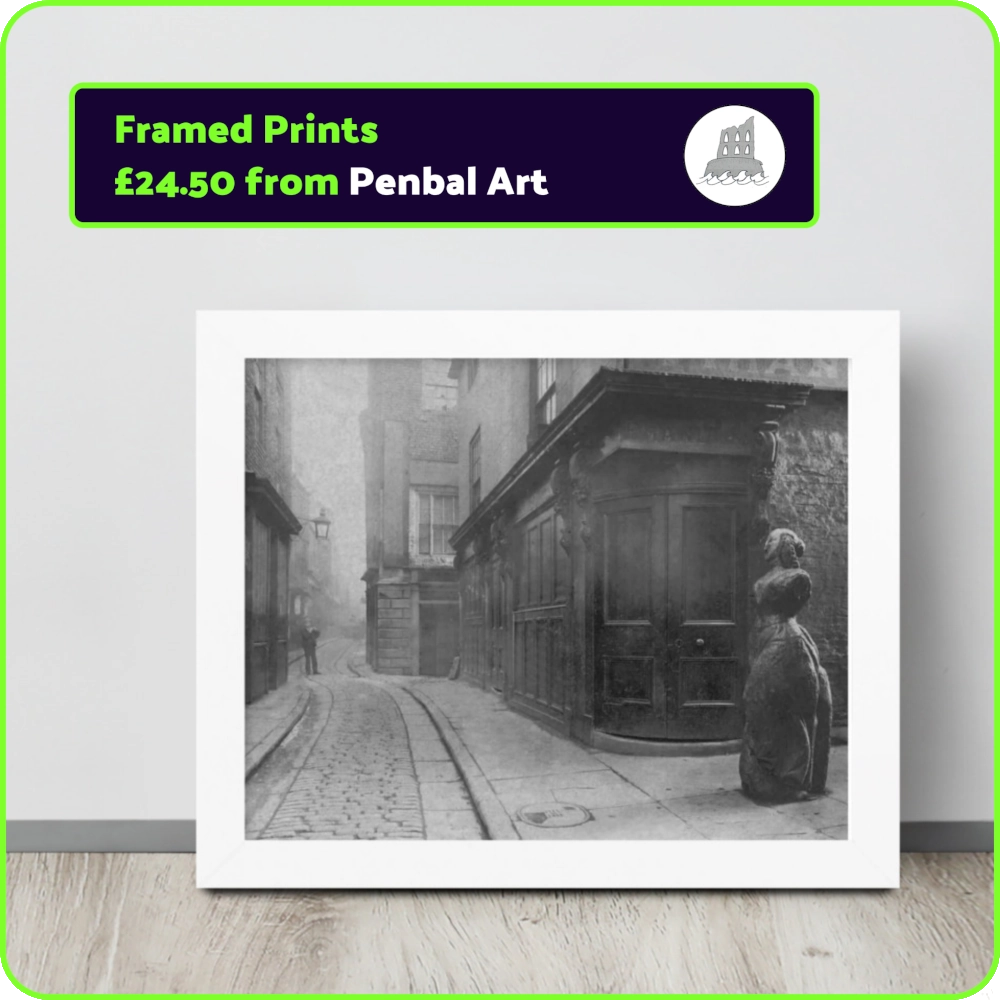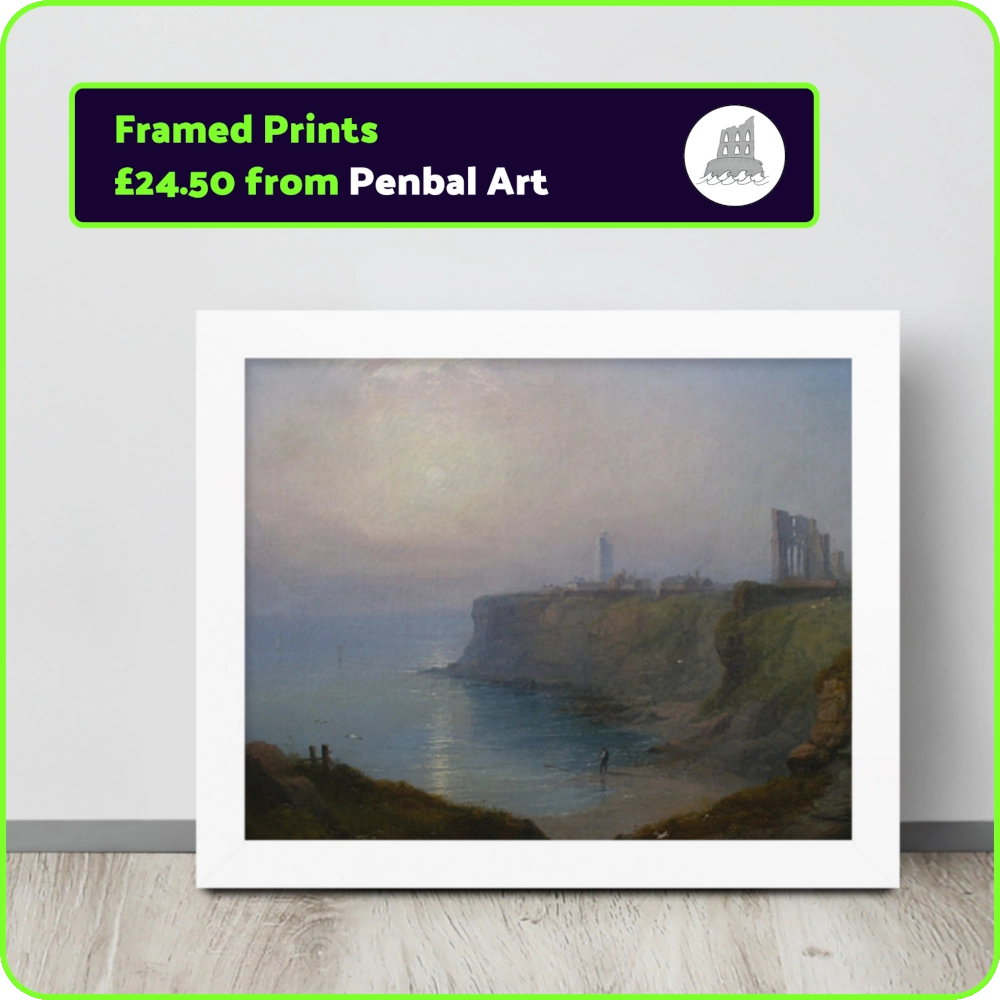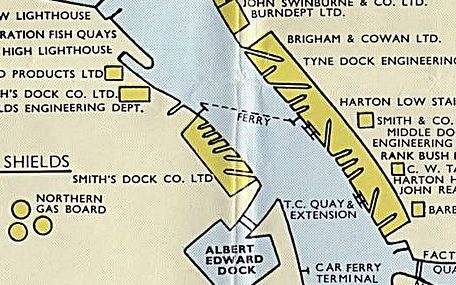
Boats on the Tyne
By Dalton Linkleter (b. 1928)
Memories of life on the river in the late 1940s and early 50s.
When the river was really busy, we that worked on or beside the water, or played in the harbour, learned to know the regular vessels that plied those waters. They became old friends, seen moving about their work.
In those days before the tunnel, we crossed the river by ferry and these were regular friends most of the time, though they slowed the pace of life to their plodding speed and the vagaries of the wind and weather.
The ferry nearest the harbour mouth was the ‘Happ’ny Dodger’, a little steam driven passengers only vessel, that sailed from a landing place on the river wall by the Market Place at the bottom of Borough Bank at North Shields, and went straight over to the south side, down among the lower ship repair yards.

The little ‘Collingwood’ provided not only a regular ‘workman’ service, but an all night service too, if you could wait long enough. It took over as a means of crossing, from the car ferry when it closed down for the night, but this crossing first involved a reasonable walk down river from the car ferry landing.
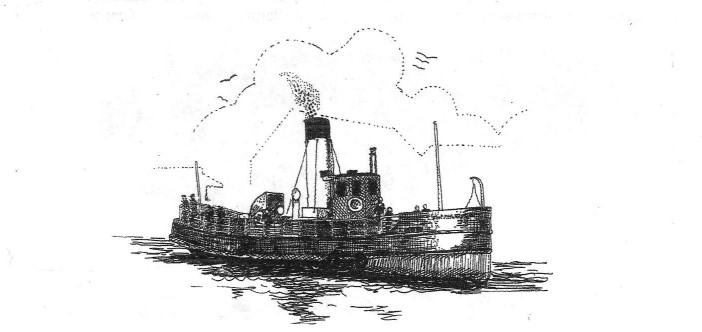
The ferry ‘Collingwood’ leaving Shields on a quiet evening.
Neighbouring the ‘Happ’ny Dodger’ on the north side was the bridge and floating pontoon of the car ferry. This service carried cars, commercial vehicles and passengers from the New Quay at North Shields up river to South Shields market place landing stage.
On its ‘mini river cruise’, which took about 15 minutes or more depending on the river traffic, it passed the busy ship repair yard of Smiths, with its associated activity and collection of bigger vessels awaiting repair. When it crossed to the south side it moved along moored tugboats, waiting colliers and more ships lying off the southside repair yards, while under the lee of each landing stage were a collection of interesting small boats, foyboats and official motor launches.
There were three of the big car carrying steam ferries available for this service, newer ‘Northumbrian’, the ‘Tynemouth’ and the old ‘South Shields’ that lay at a buoy up river from the Market Place landing, as a stand-in should one of the others be out of service.
These old steamers produced the same evocative smells that come from steam trains and traction engines; oil, smoke and hot metal.
There was a saloon for cold wet days, on the main deck and a bridge deck where one could view the river and watch the ‘driver’.

The ferry ‘Tynemouth’ starting its ‘mini river cruise’ with its assortment of transport and passengers and smoke plume.
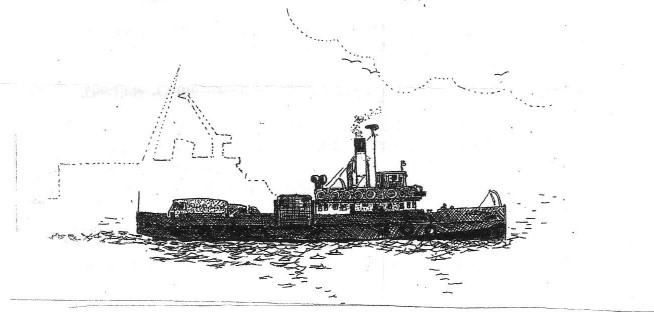
The reserve ferry ‘South Shields’ easing its way across the river on a service day.
Further up the river at Howdon the ‘A.B. Gowan’ ran a FREE vehicular and passenger ferry service to Jarrow. Another little old steam powered vessel she provided a service with the added spice of uncertainty. If the vehicle queue was to the end of the access way it could be a fifty/fifty chance that you could get round by Newcastle more quickly than waiting for the next sailing.
This little boat must have been designed in the horse and cart era, as the radius at the front of the car deck was too tight for the cars it carried to do a circuit of the deck house, so depending on the whim of the crewmen, the first group of cars was made to reverse up the near side of the house, while the next group through fed in frontwards, had to reverse out onto the rear parking area when being unloaded.
On a ‘helpful’ day, it was observed that in order to get the final car on the waiting ramp onboard, the outboard loading ramp was lowered slightly, the transversely parked coal wagon was eased forward so that its nose was just overboard and the oncoming car pressed down on its spring to allow the bonnet to rest below the tail of the lorry, protected from being scratched by an old sack.
There were many probably only half true stories of the ‘A.B. Gowan’ and its adventures during and before its voyages across the river. When for some reason the ship couldn’t sail after being loaded with cars and lorries, they were all unloaded backwatds down the ramp and up the long narrow access road back to Howdon Road. The story of lack of coal and consequent steam, letting the old girl drift off gently down river, together with her passengers.
In strong flood or ebb tides she did a lot of crawling up the slack water at the river edges after a very diagonal run across. The little steering engine produced a gentle chuckling sound heard through the car windows as she performed her various antics during the big adventure, making it sound as if she was thinking over the next joke to play on her customer, and sniggering about it.
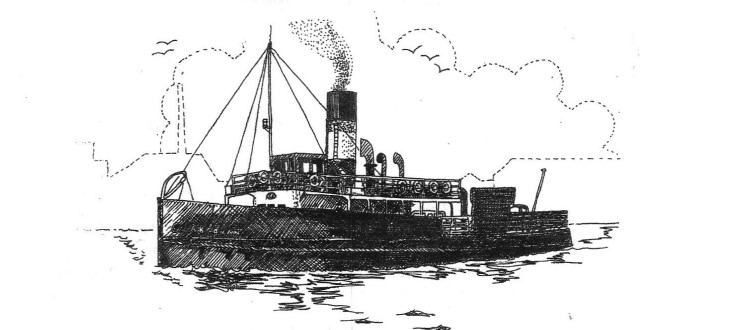
The free ferry ‘A.B. Gowan’ crossing the Tyne between Jarrow and Howdon.
Up river at Wallsend the Jarrow based Mid Tyne Ferries ran a service to cater for the shipyards and docks on both sides of the river. These motor ferries ran from Jarrow up to Walker, then back to Jarrow and over to Wallsend, then back to Jarrow.
Sailing from small floating stages each furnished with a steel hut offering shelter and a loo facility they were reached from dry land by a long girder bridge.
The little boats were covered with a corrugated iron roof and side screens of plate and glass. Their daily journeys to and from Jarrow to Wallsend, transported hundreds of workmen, to such an extent that the after finishing time arrival at the pontoon ran the risk of capsizing doe to the crush of people desperate to get off, some leaping the gap before the mooring process had been completed. The tale goes that the Captain often refused to come alongside until the gaggle spread itself out across the deck.
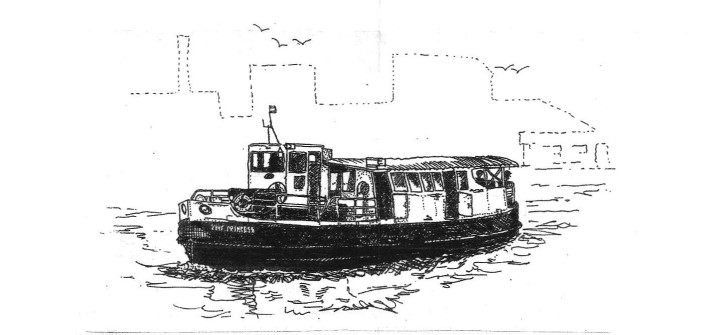
Mid Tyne Ferries vessels the ‘Tyne Princess’ and ‘Tyne Queen’ crossing to Jarrow.
On summer Saturdays and Sundays the service ran river trips down river to the harbour mouth and up river under the bridges to Ryton Willows, with occasional ‘Riverboat Shuffles’ on summer evenings.
Above this point bridges took over the river crossing, but old maps show the odd dotted line indicating other ferry crossings.
The Fish Quay at North Shields produced a rash of steam drifters and trawlers which all seemed to leave the Tyne on a Sunday afternoon, regardless of the weather conditions and we watched them as they pounded through the tide ripe at the pier ends off to the North Sea fishing grounds, trailing their plume of black coal smoke low over the water.
There were days when it looked difficult for them to find a berth at the fish quay, and to get themselves clear to of the crowd to get off to sea. Apparently some of the skippers were a ‘little worse for wear’ as they left after the pubs closed on Sunday lunch time, and reportedly chased some of the sailing fraternity round the wrong sides of the navigational buoys on their way out of the piers.
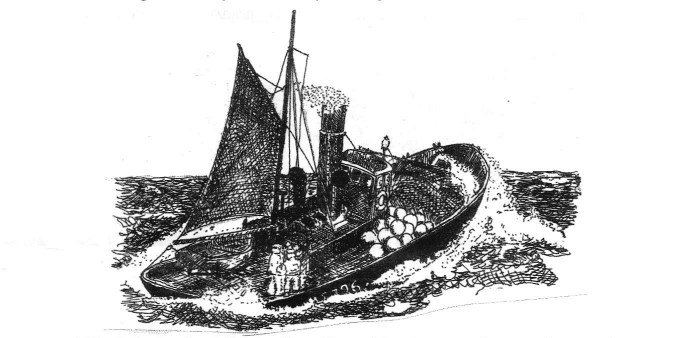
A North Sea herring drifter heading off out of the piers on a trip out to the grounds.
All the time the river carried its variety of sea going people. Colliers of all shapes and sizes and all ages heading in empty to the staiths at South Shields, Howdon, Jarrow and as far up as Dunston and out loaded with coal to London and the Continent.
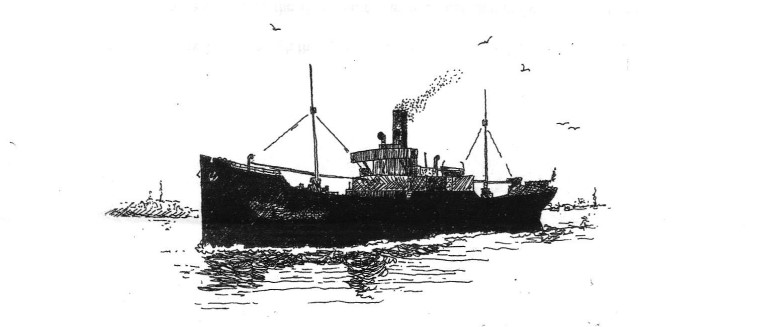
The old time collier ‘Surreybrook’ heading up river towards Dunston to take on coal.
The more modern colliers turned less romantic, but more user friendly, with low lines, virtually no bridge or funnel and a folding mast, so that they could navigate the Thames up beyond the London bridges.
Disposal of waste was always a problem and the Tyne had its two specialist ‘fly ash’ carriers, the ‘Bessie Surtees’ and the ‘Hexamshire Lass’ both serving the coal fired power station at Stella on the upper navigational reaches of the river. These special little motor ships ran off to sea, to dump the fine power station ash far away from land, so they regularly passed up and down the river, in fact it seemed that every time you walked the pier or crossed the ferry one or other was going in or out.
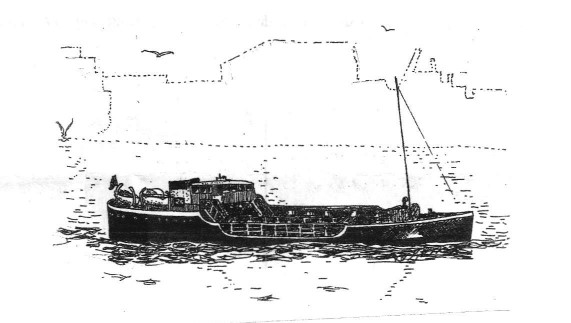
‘Bessie Surtees’ passing through the Newcastle area of the Tyne loaded with fly-ash.
All the time on all parts of the river there was a continuous activity of tug boats, always appearing in a hurry and always of familiar style. Jaunty and rakish with high bridges and heavy colourful funnels and a permanent ‘bone in their teeth’ from Newcastle to the Herd Sands they seemed to be continually busy.
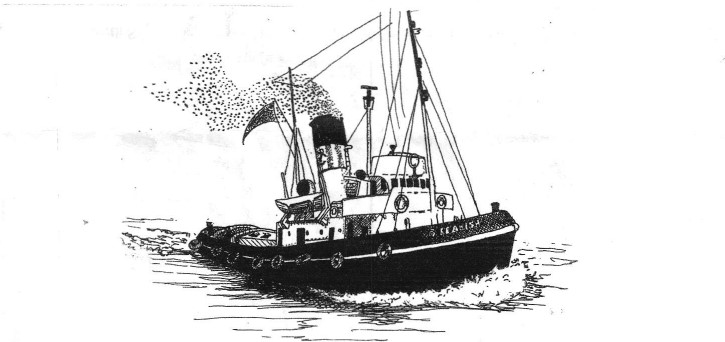
The tug ‘Beamish’ a typical Tyne tug heading off to collect some arriving ship.
Not only new tugs worked the river, these vessels seemed to be everlasting, frequently going back to the early nineteen hundreds, with paddle tugs still operating.
One of our favourites was the ‘Corn Curer’, the ‘Conqueror’ was an old two funnelled steam paddle tug that hung about the Herd Sands, the funnels were side by side while the wooden bridge was just an open box out of the top of which the skipper’s head appeared. Latterly she was very smart with the blue and white vertical stripes and black anchor symbol of the Anchor Tugs of France Fenwick.
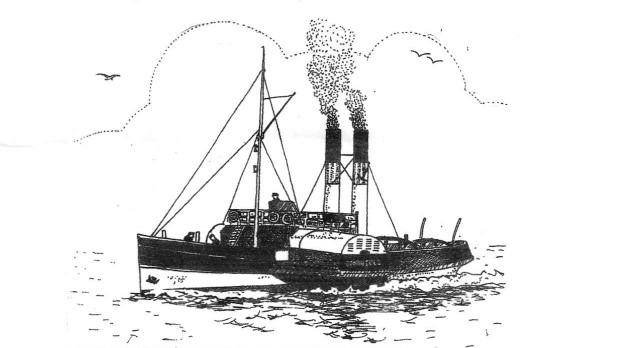
The ‘Conqueror’ stirring the foam at speed to do important business up river.
If you add to all these what seemed to be dozens of ‘foyboats’ that spawned from the Groyne Beach, the Pilot boat, the Port Medical launch and all the different yard motor launches and a great smattering of ‘pleasure’ fishing boats and all the big ships coming and going or just staying, we felt we knew them all.
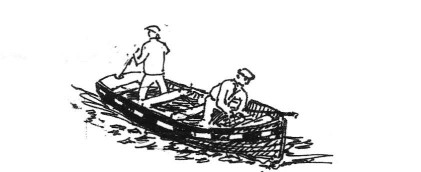
Read ‘4th July 1948 — A Line Squall’
